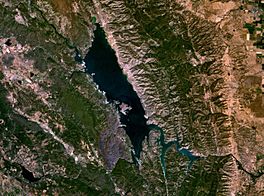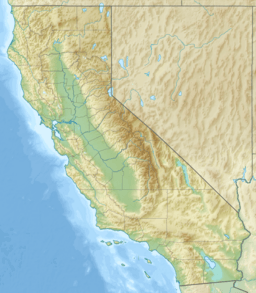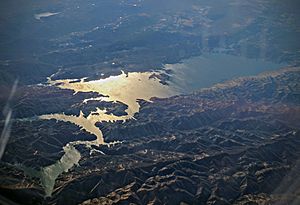Lake Berryessa facts for kids
Quick facts for kids Lake Berryessa |
|
|---|---|

Satellite photo
|
|
| Location | Vaca Mountains, Napa County, California |
| Coordinates | 38°35′N 122°14′W / 38.59°N 122.23°W |
| Type | reservoir |
| Primary inflows | Putah Creek, Pope Creek, Capell Creek, Eticuera Creek |
| Primary outflows | Putah Creek |
| Catchment area | 576 sq mi (1,490 km2) |
| Basin countries | United States |
| Managing agency | United States Bureau of Reclamation |
| Max. length | 15.5 mi (24.9 km) |
| Max. width | 3 mi (4.8 km) |
| Surface area | 20,700 acres (8,400 ha) |
| Max. depth | 275 ft (84 m) |
| Water volume | 1,602,000 acre⋅ft (1.976 km3) |
| Shore length1 | 165 mi (266 km) |
| Surface elevation | 443 ft (135 m) |
| 1 Shore length is not a well-defined measure. | |
Lake Berryessa is the biggest lake in Napa County, California, United States. It's a reservoir, which is a human-made lake. It was created in the Vaca Mountains after the Monticello Dam was built on Putah Creek in the 1950s. Since the early 1960s, Lake Berryessa has given water and hydroelectricity (power from water) to the North Bay area of the San Francisco Bay Area.
The lake got its name from the Berryessa family of California. José Jesús and Sexto "Sisto" Berryessa were given land called Rancho Las Putas in 1843.
Contents
About Lake Berryessa's Size and Features
Lake Berryessa is very large. When it's completely full, it covers over 20,000 acres (80 km²). It is about 15.5 miles (25 km) long but only 3 miles (5 km) wide. The shoreline around the lake stretches for about 165 miles (265 km).
The Glory Hole Spillway
Near the dam, on the southeast side of the lake, there is a special drain called the Glory Hole. It looks like a giant bell-shaped funnel. This spillway is 72 feet (22 m) wide at the top. Water drops straight down for 200 feet (61 m) through a pipe that shrinks to about 28 feet (8.5 m) wide.
The Glory Hole works when there is too much water in the lake. It helps to release extra water safely. It can handle a huge amount of water, up to 48,000 cubic feet per second. In 2017, after a lot of rain, it started flowing for the first time since 2006. It's important to stay away from the Glory Hole when it's active because the water flow is extremely powerful and dangerous.
History of Lake Berryessa
Before the lake was made, the valley was a rich farming area. The main town there was Monticello. This town had to be moved so the reservoir could be built. Photographers Dorothea Lange and Pirkle Jones wrote a book called Death of a Valley about this event.
Building the Monticello Dam started in 1953 and finished in 1958. The lake filled up by 1963. At that time, it was the second-largest reservoir in California. The Monticello Dam and Lake Berryessa are part of a bigger plan called the Solano Project. This project also includes the Putah Diversion Dam and Lake Solano.
Monticello Town and Its People
The people living in Monticello did not want the dam to be built. They fought against the government's Solano Project, but they were not successful. Residents had to leave their homes, and the town's cemetery was moved. Houses were destroyed, and the fertile farmland was flooded.
Monticello was a small farming town started in 1867. About 250 people lived there when the dam project began. Putah Creek was very important to the town. It gave them water for their crops and animals. People raised cattle and grew grain. They also had orchards, pigs, and sheep. Monticello was a small but self-sufficient town. Its people had connections with nearby towns like Winters and Davis. Even though it was a small town, the residents of Monticello and Napa County fought against the dam all the way to Washington D.C. Almost everything from the town was removed or destroyed. However, one bridge over Putah Creek was left behind. It is now deep under the lake's water.
Why the Dam Was Built
The discovery of gold in California brought many people to the central valley. Towns in Solano County grew quickly. More water was needed for the growing population. So, around the 1940s, the Solano County Water Council looked for the best place to build a water project. The Monticello Dam and Lake Berryessa were the result.
People started thinking about damming Putah Creek in the early 1900s. Engineers studied the idea in 1907. While larger projects became more popular, the idea of a dam here stayed alive. Small irrigation projects in the area had not been very successful. Finally, the Solano Water Council decided to focus on the Monticello Dam. The best place for the dam on Putah Creek was at a spot called Devil’s Gate.
A Bigger Lake Idea
A few years after the dam was finished, Governor Edmund G. Brown suggested building an even bigger dam and lake. This "Greater Berryessa Project" would have been much larger. The dam would be 600 feet (183 m) tall, holding ten times more water. The lake would be three times its current size, flooding more farmland. This plan was too big and expensive to become real.
How Lake Berryessa Works (Hydrology)
The lake gets its water from the 576-square-mile (1,490 km²) Putah Creek area. It can hold a lot of water, about 1,602,000 acre-feet (1.976 km³). This makes it one of California's larger reservoirs. Besides Putah Creek, three other main creeks feed the lake: Capell Creek, Pope Creek, and Eticuera Creek.
These smaller creeks do not always flow at the same rate. Their water levels depend on how much rain falls where they start. They mostly bring water in the winter or wet season and often dry up in the summer. Putah Creek is the only one that is dammed.
Managing Water and Floods
Lake Berryessa is part of the Solano Project, which also includes Lake Solano and the Putah South Canal. Lake Berryessa is the largest and most famous part of this project. It helps control floods in Yolo County. It is estimated that the lake has saved over five million dollars by preventing flood damage in its first forty years.
It is very rare for Lake Berryessa to overflow. It has only gone above 440 feet (134 m) a few times, including on February 17, 2017. Experts believe there is only a one percent chance of the lake reaching 450 feet (137 m). The highest water level ever recorded was 446.7 feet (136.1 m).
Lake Berryessa provides water to towns like Vacaville, Suisun City, Vallejo, and Fairfield. It also supplies water to Travis Air Force Base. The Solano County Water Agency (SCWA) helps manage the lake's water levels. They have a "Drought Contingency" Plan. This plan helps them find water for the towns if the lake level gets too low.
Even though the lake and dam are in Napa County, most of the water goes to Solano County. It is used for farming, city needs, and industry. A small amount of water is used around Lake Berryessa in Napa County. The dam also has a power plant built in 1983. It can make up to 12 megawatts of hydroelectric power.
Lake Turnover
Lake Berryessa is a monomictic lake. This means its waters mix completely once a year, usually in the fall. This mixing happens when the warmer water at the top cools down to match the cooler water below. When the lake is all the same temperature, water can move freely. This helps bring oxygen to parts of the lake where it was low. Fishing can be harder during or after this time because fish can go anywhere in the lake.
The lake is also very important for refilling the groundwater in the areas around it. Without the dam, Putah Creek could dry up in the summer.
Managing Lake Berryessa
When Monticello Dam and Lake Berryessa were first made, they were not meant for public fun. The lake was fenced off at first. But many people still wanted to visit the water. Since no government agencies wanted to manage the lake, seven companies were allowed to offer fun activities to the public in the late 1950s.
These companies had contracts for 50 years, which ended in 2009. During that time, they rented land to people with RV homes for long-term living. When the contracts ended, all the fun places and mobile homes had to move off the federal land. The government has not yet started many new fun activities at the lake. A new walking trail might be built in the future. After the contracts ended, fewer people visited Lake Berryessa. The government estimated that visits dropped by more than half.
Protecting Against Invasive Mussels
The SCWA also works to control zebra mussel and quagga mussel infestations at Lake Berryessa. These are invasive mussels that can harm the lake's ecosystem. A program has been running for over 15 years to teach boaters about these mussels. Any boat that has been in waters known to have these mussels must wait 30 days before coming back to Lake Berryessa. However, this program only runs during certain seasons because of limited money and staff.
In 2007, a study looked at the lake bed to see if the lake had lost any of its water storage space due to mud and dirt building up. The study found that Lake Berryessa has not lost any of its storage capacity.
Fun Things to Do at Lake Berryessa
Lake Berryessa is a great place for many activities! You can go fishing, waterskiing, jet skiing, or just enjoy a boat ride. People also like kayaking, canoeing, hiking, and bicycling. It's a good spot for watching birds and other wildlife, having picnics, and swimming.
There is even a special place on the lake's surface for seaplanes to land. It's called the Lake Berryessa Seaplane Base.
Boating and Swimming
The part of the lake closest to the Monticello Dam is called the "Narrows." This area can get very busy with boats on holidays and weekends. There are several resorts with marinas (places to dock boats) at the lake. You can also find Lake Solano County Park nearby.
There are special areas for swimming where boats are not allowed. You can also find several hiking trails around the lake.
Fishing at Lake Berryessa
Fishing at Lake Berryessa is popular all year round. The lake has both warm-water and cold-water fish. You can find many types of fish, from sunfish to salmon. Because there are so many kinds of fish, you can try different ways of fishing.
Fish you might catch include:
- Largemouth bass
- Smallmouth bass
- Spotted bass
- Channel catfish
- Bullhead catfish
- White catfish
- Carp
- Sacramento pikeminnow
- Crappie
- Bluegill
- Rainbow trout
- Brown and brook trout
- Kokanee
- Chinook salmon
The rainbow trout is native to this area. Many other fish, like largemouth and smallmouth bass, were brought to the lake later. Bass and salmon are popular for sport fishing. Bluegill, crappie, and catfish are good for beginners. Carp and pikeminnow are usually not favored by anglers.
The California Office of Environmental Health Hazard Assessment (OEHHA) has given advice about eating fish from Lake Berryessa. This is because of higher levels of mercury in some fish. You can find these guidelines at the Lake Berryessa's Visitor Center. For now, trout are the best fish to eat from Lake Berryessa regarding mercury levels. Fishing rules follow the standard California Department of Fish and Wildlife regulations. There are also bass fishing tournaments held most months of the year.
Hunting Rules
Hunting is not allowed on lands around Lake Berryessa that are managed by the Bureau of Reclamation. However, firearms are allowed on these lands under certain rules. For example, you might need a special permit or the firearm must be taken apart. Hunting can be done on lands managed by other agencies next to the lake, like Knoxville Wildlife Area. These areas are managed by the California Department of Fish and Wildlife or the Bureau of Land Management. Hikers are also in these areas, so safety is very important.
Cedar Roughs Wilderness
Next to the Lake Berryessa Recreational Area is the Cedar Roughs Wilderness Area. This special area was set aside in 2006. It covers 6,350 acres (25.7 km²) and is located about 1.8 miles (2.9 km) past the Pope Creek bridge. You can get to this wilderness area by car or boat. However, there are no marked trails. Hiking can be tough because more than half of the area is covered in Sargent's cypress trees. These trees are genetically very pure. This area is managed by both the Bureau of Land Management and the California Department of Fish and Game.
Plants and Animals (Flora and Fauna)
Many interesting plants grow in the Lake Berryessa area. These include Sargent cypress, white alder, leather oak, Jepson's navarretia, and Bridge's brodiaea.
On the east side of the lake, there is a 2,000 acre (8.1 km²) Wildlife Management Area. This area is managed by the California Department of Fish and Game. It protects homes for many animals, such as:
- Mountain lion
- Black-tailed deer
- Western rattlesnake
- Raccoon
- Skunk
- Osprey
- Turkey
- Rabbits
- Golden eagle
See also
 In Spanish: Lago Berryessa para niños
In Spanish: Lago Berryessa para niños




